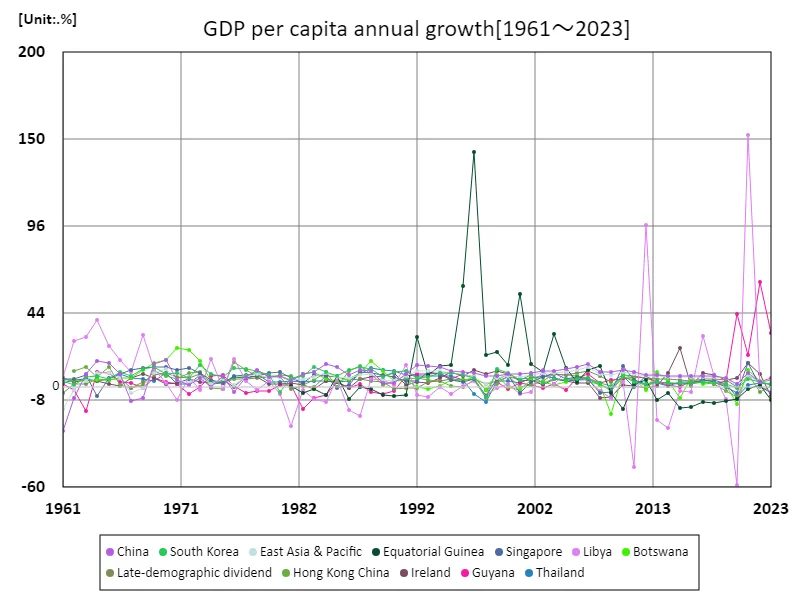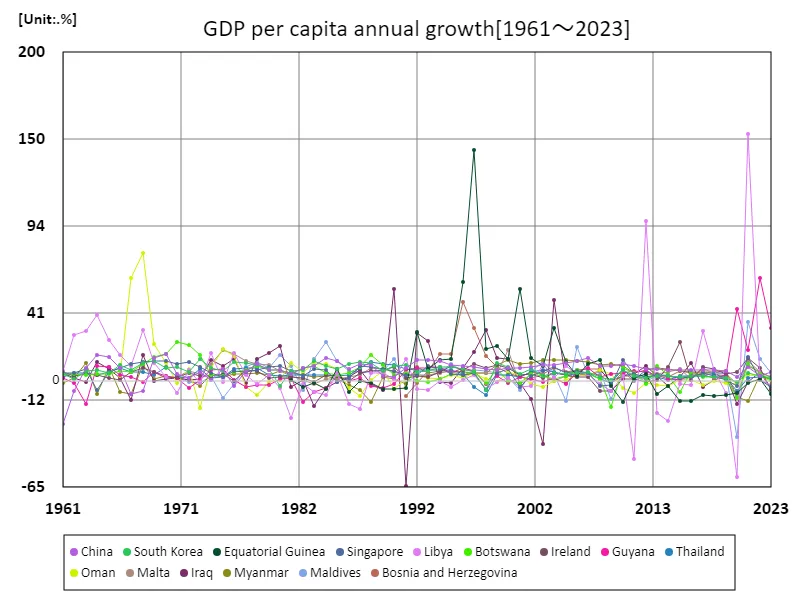Abstract
Guyana’s high annual GDP per capita growth rate of 32.2% in 2023 is mainly due to its economic growth as an emerging country and its abundant resources. Guyana has experienced a significant increase in its oil and natural gas reserves in recent years, which is expected to have a positive impact on the overall economy. On the other hand, such rapid growth rates have raised questions about sustainability, pointing out the need to move away from a resource-dependent economy and to implement policies that will return growth to citizens in a more comprehensive way. Additionally, in the case of Guyana, the country is highly dependent on fluctuations in the prices of natural resources, so fluctuations in international markets can have a significant impact on its growth rate. Going forward, achieving both sustainable economic growth and social development will be an important issue.
Annual growth rate of GDP per capita
The annual growth rate of global GDP per capita has shown different patterns across countries and regions. Resource-rich countries in particular can experience strong growth rates due to fluctuations in natural resource prices, but at the same time they tend to be vulnerable to these effects. Libya, for example, has been heavily impacted by fluctuations in the oil industry, with growth peaking at 150% in 2021 but then dropping to -1.83% since. Such sudden fluctuations highlight economic instability and sustainability issues. On the other hand, there are countries where growth rates remain stable and high over the long term. This is supported by a variety of factors, including education, technological innovation and policy stability. Fluctuations in economic growth rates are heavily influenced by domestic and international economic policies and international market trends, so there is an increasing need for predictions and measures. In the future, strategies to balance sustainable growth with social inclusion will become increasingly important.


The maximum is 150%[2021] of Libya, and the current value is about -1.83%
Annual growth rate of GDP per capita (nations around the world)
Annual growth rates of GDP per capita around the world vary widely, with some seeing large fluctuations, such as in Libya. Looking at data from 1961 to 2023, Libya recorded a growth rate of 150% in 2021, but has since fallen to -1.83% due to economic instability and fluctuations in resource prices. Such rapid changes are a trend seen in countries that are highly dependent on the oil industry. Fluctuations in resource prices can have a major impact on the economy, making growth rates difficult to predict. On the other hand, there are countries where per capita GDP growth rates have remained stable and high. This is a combination of education, innovation, and stable economic policies. Economic diversification, infrastructure development and social inclusion are important to achieve sustainable growth. Economic diversification and domestic stabilization will be key challenges going forward, particularly for a country like Libya. In order to achieve both a stable and sustainable economic growth rate, it is necessary to take into account a variety of domestic and international factors in a comprehensive manner.


The maximum is 150%[2021] of Libya, and the current value is about -1.83%
Annual growth rate of GDP per capita (nations around the world, latest year)
The annual growth rate of GDP per capita around the world varies greatly between countries and regions. The latest data for 2023 shows Macau recorded the highest growth rate of 78.2%. Macau’s high growth rate is due to the rapid development of its tourism and gaming industries, and reflects the characteristics of the local economy. However, the overall average growth rate was 2.15%, a general indicator of global economic growth. Historically, emerging economies and countries dependent on specific industries have tended to experience high growth rates, while mature economies and resource-poor countries have tended to experience more modest growth rates. The total growth rate of 371% indicates that economic growth has been cumulative. This reflects the evolution and changes in the global economy over the past few decades, particularly with the rapid pace of economic growth in the Asia-Pacific region and some Latin American countries. Looking ahead, technological innovation and commitment to the Sustainable Development Goals will be key to keeping growth rates sustainable. Analysis of economic growth rates plays an important role in understanding the trends of the global economy and formulating appropriate policies.


The maximum is 78.2% of Macao, the average is 2.14%, and the total is 368%



Comments